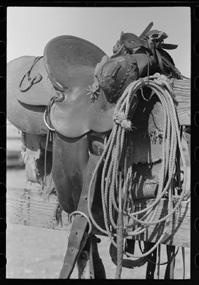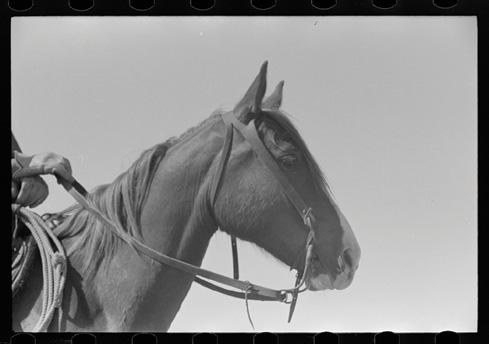
4 minute read
Tools of the Trade
TOOLS OF THE TRADE: THEN & NOW
ARTICLE BY TAMRA KELLY
Advertisement

He most likely had stuck an extra horseshoe and handful of nails along with set of fencing pliers in the pocket of his chaps. Tacking on a shoe to limp back to the ranch was often necessary in the rough, rocky country of Central Arizona. Leaving before daybreak – he got back home when he got back home. No time. No deadlines. No hurry. Work the cows, ride his country, and come back home when he was ready.
Spring works were less complicated. Drag calves to the fire, brand, give them an ear-mark, give a shot of black leg and turn them back out. In the fall, gather, wean the calves, fill out your self-inspect papers, load them on the trucks and ship to the sale barn. Simple – few laws, little regulation, no cell phones, no computers. Times have changed.
Although the basic tools of the trade remain the same, producing and managing a cattle herd has become much more complicated. With extremely narrow profit margins a constant concern, paying close attention to everything aspect of the business is required. Breeding programs, genetics, birthing weights, average weight gains, feed supplements, fuel prices, maintenance costs, minerals and vaccinations require careful and consistent planning in an effort to maximize profit.
Unfortunately, the computer and the cell phone have become basic tools of the trade. It seems that every cowboy now spends much time on his cell phone. Whether talking cattle, business, calling home or playing on social media the freedom of being horse back in peace with no limits regarding time, location or progress is now almost impossible. If the cell phone in your pocket is not enough, now every headquarters has computers and Internet with wireless modems to assist the rancher in research, buying, communication and marketing. The Internet has increased our ability to research issues and communicate concerns regarding the challenges facing the producer. Reviewing Market Report and cattle futures or purchasing every kind of ranch supply from drinkers and solar pumps to barb wire is conveniently accomplished online. Moreover, internet sales of cattle through websites such as Superior Livestock, Roundup Cattle, Ranch World Ads, etc. are becoming a popular method to sell cattle.
These internet sales with more complex “value added programs” are becoming the norm. As an example, Superior Livestock has no less than six different vaccination programs – VAC 24, VAC34, VAC 34+, VAC 45, VAC 45+ and Vac Precon each with specific vaccines and most requiring double vaccinations of calves. Shots at the time of branding and the second prior to weaning are designed to minimize death loss in the feedlots increasing the value of your calves. In addition the VAC 45, 45+ and Vac Precon require the calves to be weaned for at least 45 days before shipping to further minimize the possibility of loss in grow yards.
If vaccination options are not complicated enough, Superior Livestock offers additional programs such as Source Verified, Source and Age Verified, Progressive Genetic, Right Slide, Weight Stop, BVD PI Free, NHTC, Gap 1 and Gap 4, Owner Certified Natural, Certified Natural Plus, Verified Natural Beef, Vita Form Raised, Gain Smart and Genetic Merit Programs each designed to enhance the opportunity to obtain a better price for your calves. However, the simplicity of the cattle business is lost and these new programs are sometimes met with great resistance from older producers who prefer the historic practice of one shot at branding and ship on the day of weaning.
The complexity of the business is no longer simply related to a rancher’s ability to producing a calf. Knowledge regarding everything from cattle futures to internet modems is necessary for a profitable cattle operation. Unexpected expenses can cut deep into the profit margin. Anything you can do yourself from simple equipment maintenance, welding, and veterinarian skills to pulling a windmill or properly filing for a water right, avoids the necessity of outside help greatly reducing the cost of doing business.
The weather, the general public and the government can, and often do, create unexpected expenses. Floods, snow storms, or drought cost money. People cutting fences, shooting cattle, or leaving gates open creates expense. Government regulations, laws and restrictions can turn a profitable year into a deficit. Effective written and verbal communications are often the only tools available to minimize these costs.
Ranching on public lands has its own special problems. Knowledge and understanding of policy, regulation and statutes relating to public lands management is critical for proper and effective communication with land managers. Speaking their own language riddled with regulations, departmental titles and acronyms such as NEPA, AOI, EA, EIS and FLMPA federal land managers can obfuscate simple concepts often creating bewilderment to the cattle producer attempting to simply manage the range to produce a calf. The better you understand and can communicate with public land managers, the more effective your cattle operation.
When we work our cattle ranches in Central Arizona everyone in my family still carries the same tools my grandpa carried. Saddle, chaps, rope, pocket knife and matches. Sometimes in areas with no cell service, we still build a smoke to communicate. The joy of taking care of our cattle with a few simple tools in a remote, isolated part of Arizona is priceless. Unfortunately, when we come back to town – the nature of the business and its required tools have become far more complex.

ABOUT THE AUTHOR: Tamra Kelly is the broker of Ag Lands Southwest, LLC - a real estate company specializing in the sale of cattle ranches and other agricultural properties in Arizona and New Mexico. To see current listings flip to the back of Western Ag Life Magazine or visit: www.aglandssw.com Buying or Selling a ranch or farm? Contact her today at: 928-830-9127.










